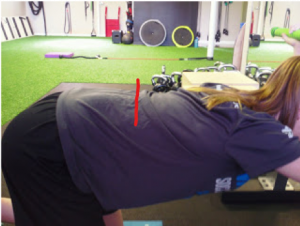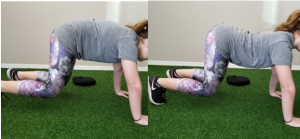Drills to Correct Posterior Pelvic Tilt
By: Coach Laura Rogers
Posterior pelvic tilt is no new phenomenon. It needs to be a priority in correcting if your athletes are prone to extreme postures; like this one (don’t worry, we fixed him), but this kid always struggled with the drills we talk about in this article. When the athletes cannot distinguish between low back, pelvis and hamstrings, you have a major problem! Since you can’t just tell a young athlete, “feel this,” or “move that body part,” these drills help them understand what they should be feeling.
Since this is written to educate trainers and performance coaches on unique ways to correct this for their athletes, we’ll jump right into the good stuff. We’ve given you three unique drills explained in this video, but first make sure you know what to look for. Below are examples so you know exactly what to focus on to help these athletes.
To summarize, a posterior tilt leaves the hamstrings short (tight), glutes weak, abdominals shortened, and quads inactive. When they need to find an extension pattern it will come from excessive mid-thoracic spine and rib cage shift. When these athletes squat it can appear that they are very quad dominant because they are not using their glutes and will be standing by forced knee extension. This does not make their quads strong, it makes them fire improperly, leaving them structurally weak and prone to injury. Here’s an example:
Now take for example this athlete that has extreme opposite mechanics; this athlete heavily relies on the arch to brace posture, still appears to be quad dominant, but lives in anterior pelvic tilt. This type of athlete would never do the drills in this article.
These drills are all for heavily shifted posterior athletes, here are other examples of this posture:
The very rounded left photo shows the pelvis rolled under. To ask this athlete to sit tall, she just arched her low back. You have to ask them to physically tip their pelvis the other way.
Rib cage shifts, low back muscles are over-developed and round. This same fault is mimicked in the down dog position.
They don’t have the ability to move their pelvis and activate those low back muscles into flexion so movement comes through the rib cage.
With a squat their knees go forward. In down dog, they can’t shift their hips, so the low back rounds and the rib cage creates extension beyond what it should.
With this athlete, I asked her to lift her knees off the ground (left picture), which is her natural, (showing extreme posterior tilt). When I asked her to push her hips to the ceiling, you get the right picture- extreme extension through the rib cage shifting, pelvis didn’t actually move, but she thought it did. This correlates to our strengthening drills in the video to correct this posture.
Your athletes will hate it at first. It may put some into a “panic” where they cannot calm down- they wiggle, they complain of pain, they cannot handle these dramatic corrections. To that, I say, like all exercises, “give it time.” Be patient with them, teach them to be calm, work towards longer durations, never force it in the beginning. We’re talking about changing muscles that tend to get injured and “talk back” easily, so ease athletes into these corrections.
Check out the video below to explain these drills:
1. Learn pelvic stability while put under extreme anterior tilt correction. They need to understand what it feels like, so make sure they keep that tailbone on the floor through movement, but move slowly and take breaks as needed.
2. Hamstring stretch. These athletes don’t know how to separate the low back, pelvis, and hamstrings so we have to make a variation that’s extreme so they connect the new feeling and only stretch their hamstrings; not their low back like they are used to.
3. Improve strength and neurological control. After they gain some understanding, start to make them strong in the new position. Lots of practice is needed here. Most of the day these athletes sit with terrible posture, so a quick strengthening drill once or twice a week won’t fix anything quickly. Have them practice these three drills as often as possible!
NOTE: After doing all of these and the athlete gets up, don’t let them “stretch.” An athlete may immediately bend over or want to round their back. Do not let them do this. We are trying to break that habit, so while it feels so wrong for them, do not let them undo all the corrections you just did!
For more repositioning techniques, see Essential Movement Qualities: Hip Internal Rotation.
About the Author:
Coach Laura Rogers is a performance coach and owner of Top Notch Training, a sports performance facility in St. Petersburg, Florida. Originally from Colorado, Laura grew up playing competitive fastpitch softball. She moved to Florida after college, and has been working in the fitness industry for over 8 years. Laura has been an Assistant Sports Performance Director for two other centers and has worked as a Personal Trainer before living her dream of opening Top-Notch Training.
Laura earned her bachelor’s degree in Exercise Science from the University of Northern Colorado. She is a Certified Strength and Conditioning Specialist through the NSCA, an Olympic Lifting, Sports Performance Coach with USA Weightlifting, Functional Movement Screen (FMS), ViPR Coach, a Youth Fitness Specialist, and a High School Strength and Conditioning Specialist.
Coach Laura started Top-Notch Training to give kids a place to work out, improve their fitness, and become better athletes. The main goal is to provide the best methods of training to help athletes improve their game by increasing speed, power, agility, strength, stamina, coordination, and flexibility.








0 Comments for “Drills to Correct Posterior Pelvic Tilt”